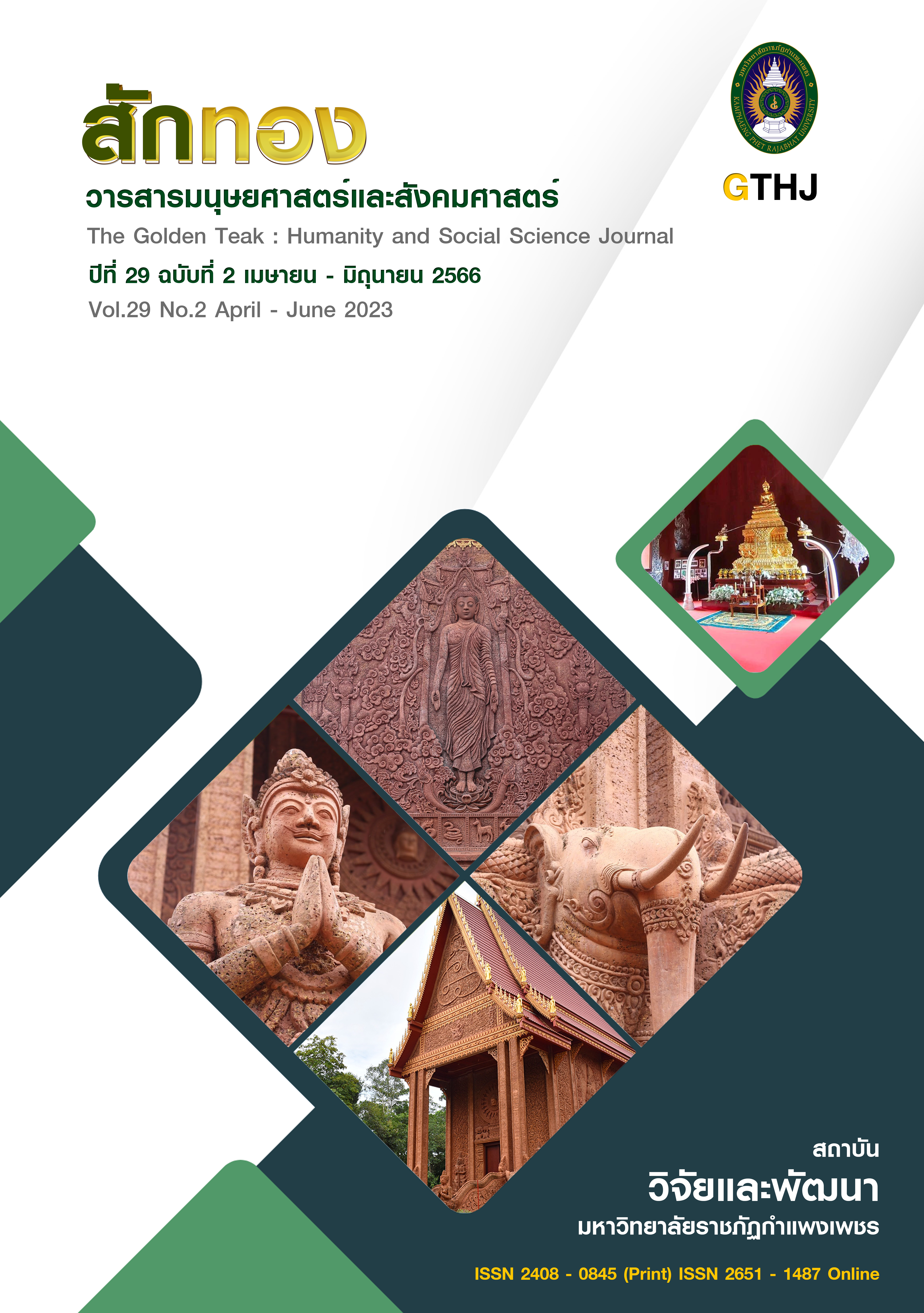The Influence of Festivalscape Components on Festivalgoers’ Memorable Experience: A Case Study of the Cat Expo Music Festival
Main Article Content
Abstract
Music festivals are increasingly popular in Thailand. As a result, organizers must understand how to provide their visitors with a memorable experience. The purposes of this research paper were to 1) examine the festivalscape components for the music festival and 2) examine the festivalscape components that influenced the memorable experiences of the music festival participants. This is a quantitative study. A questionnaire was utilized to collect data by convenient sampling. The sample consisted of 389 attendees at the 8th annual Cat Expo music festival. The data was analyzed using descriptive statistics. Exploratory factor analysis and multiple regression analysis. According to the findings, four festivalscape components were characterized as follows: 1) facilities and atmosphere, 2) program and information, 3) on-stage entertainment, and 4) souvenirs and activities. The study of the influence of festivalscape components on participants' memorable experiences discovered that program and information had the greatest influence on music festival participants' memorable experiences, followed by on-stage entertainment, souvenirs and activities, and convenience and atmosphere, respectively. The study findings will contribute in the development of a music festival format that will provide attendees with a memorable experience.
Article Details

This work is licensed under a Creative Commons Attribution-NonCommercial-NoDerivatives 4.0 International License.
บทความที่ได้รับการตีพิมพ์เป็นลิขสิทธิ์ของวารสาร สักทอง : วารสารมนุษยศาสตร์และสังคมศาสตร์ สถาบันวิจัยและพัฒนา มหาวิทยาลับราชภัฏกำแพงเพชร
ข้อคิดเห็นใดๆ ที่ปรากฎในวารสารเป็นวรรณกรรมของผู้เขียนโดยเฉพาะ ซึ่งมหาวิทยาลัยราชภัฏกำแพงเพชรและบรรณาธิการไม่จำเป็นต้องเห็นด้วย
References
Bangkok Post (2020). TCEB launches ‘Festival Economy’. [Online]. Available : https://www.bangkokpost.com/thailand/pr/2036487/tceb-launches-festival-economy [2022, June 10]. [In Thai]
Best, J.W. (1981). Research in Education. (4 th ed.). Englewood Cliffs, NJ: Prentice-Hall.
Brown, A. E., & Pappas, N. (2021). Added value and music events : a festivalgoer perspective. Annals of Leisure Research, 1-23.
Brown, A. E., & Sharpley R. (2019). Understanding festival-goers and their experience at music festivals. Event Management, 23(4), 699-720.
Carissa, A., Natalia, J., Lasini, M. & Gunadi, W. (2020). Understanding The Role of Sensory, Emotional, Social And Memorable Experiences In Behavioural Intention Of Indonesia’s Music Concert Industry. International Journal of Scientific & Technology Research, 9(1), 370-381.
Carneiro, M.J., Eusébio, C., Caldeira, A. & Santos, A.C. (2019). The influence of eventscape on emotions, satisfaction and loyalty: The case of re-enactment events. International Journal of Hospitality Management, 82, 112-124.
Chen, Z., King, B. & Suntikul, W. (2019). Festivalscapes and the visitor experience: An application of the stimulus organism response approach. International Journal of Tourism Research, 21(6), 758-771.
Cochran, W.G. (1977). Sampling techniques. (3 rd ed.). New York: John Wiley and Sons.
Cronbach, L.J. (1990). Essentials of psychological testing. (5 th ed.). New York: Harper & Row.
Ding, H.M. & Hung, K.P. (2021). The antecedents of visitors' flow experience and its influence on memory and behavioral intentions in the music festival context. Journal of Destination Marketing & Management, 19, 1-11.
Getz, D. & Page, S.J. (2016). Progress and prospects for event tourism research. Tourism Management, 52, 593–631.
Goncalves, O., Camprubí, R., Fons, C. & Solonandrasana, B. (2022). Image, eventscape, satisfaction and loyalty: a case study of a wine tourism event. International Journal of Event and Festival Management, 13(1), 18-37.
Hair, J.F. Jr., Black, W.C., Babin, B.J. & Anderson, R.E. (2010). Multivariate Data Analysis. (7 th ed.). Upper Saddle River, NJ : Pearson Prentice Hall.
Harman, H.H. (1976). Modern Factor Analysis. (3rd ed.). Chicago: University of Chicago Press.
Hodur, N.M., Bangsund, D.A., Leistritz, F.L. & Kaatz, J. (2006). Estimating the contribution of a multi-purpose event facility to the area economy. Tourism economics, 12(2), 303-316.
Janprasit, W. (2019). Event tourism: a new alternative for sustainable tourism. Silpakorn University Journal, 39(6), 104-125.
Kaiyawan, Y. (2003). Multivariate statistical analysis for research. Bangkok : Chulalongkorn University Press. [In Thai]
Kerlinger, F.N. (1986). Foundations of Behavioral Research. (3 rd ed.). USA : Hort, Rinehart and Winson.
Kruger, M. & Saayman, M. (2018). All that jazz’: The relationship between music festival visitors’ motives and behavioural intentions. Current Issues in Tourism, 22(1), 1-16.
Lee, J.S., Lee, C.K. & Choi, Y. (2011). Examining the role of emotional and functional values in festival evaluation. Journal of Travel Research, 50(6), 685–696.
Lee, T.H. & Chang, P.S. (2016). Examining the relationships among festivalscape, experiences, and identity: Evidence from two Taiwanese aboriginal festivals. Leisure studies, 36(4), 453-467.
Lee, Y.K., Lee, C.K., Lee, S.K. & Babin, B.J. (2008). Festivalscapes and patrons’ emotions, satisfaction, and loyalty. Journal of Business Research, 61(1), 56–64.
Manners, B., Kruger, M. & Saayman, M. (2016). Managing Live Music Performances: A Demand and Supply Analysis. Event Management, 20(2), 147-163.
Mason, M.C. & Paggiaro, A. (2012). Investigating the role of festivalscape in culinary tourism: The case of food and wine events. Tourism management, 33(6), 1329-1336.
Moufakkir, O. & Selmi, N. (2018). Examining the spirituality of spiritual tourists: A Sahara desert experience. Annals of Tourism Research, 70, 108–119.
Nguyen, T., Lee, K., Chung, N. & Koo, C. (2020). The way of generation Y enjoying Jazz festival: A case of the Korea (Jarasum) music festival. Asia Pacific Journal of Tourism Research, 25(1), 52-63.
Pine, B., & Gilmore, J. (1998). Welcome to The Experience Economy. Harvard Business Review, 76(4), 96-105.
Pongwichai, S. (2009). Statistical Analysis by Computer Focused on Research. (20 th ed.). Bangkok : Chulalongkorn University Press. [In Thai]
Selmi, N., Bahri-Ammari, N., Soliman, M. & Hanafi, I. (2021). The impact of festivalscape components on festivalgoers’ behavioral intentions: The case of the International Festival of Carthage. Journal of Convention & Event Tourism, 22(4), 324-345.
Soliman, M. (2015). Pro-poor tourism in protected areas–opportunities and challenges: The case of Fayoum, Egypt. Anatolia, 26(1), 61-72.
Tangit, T.M., Kibat, S.A. & Adanan, A. (2016). Lessons in managing visitors experience: the case of Future Music Festival Asia (FMFA) 2014 in Malaysia. Procedia Economics and Finance, 37, 52-57.
Torabi, Z.A., Shalbafian, A.A., Allam, Z., Ghaderi, Z., Murgante, B. & Khavarian-Garmsir, A.R. (2022). Enhancing Memorable Experiences, Tourist Satisfaction, and Revisit Intention through Smart Tourism Technologies. Sustainability, 14(5), 1-18.


